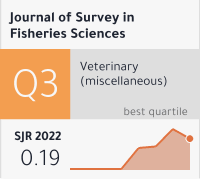Study of the Mullusca Community in The Reclamation Beach of Manado Beach
DOI:
https://doi.org/10.17762/sfs.v10i1.568Keywords:
Community Structure, Mollusc, Reclamation.Abstract
This study aims to inventory the types of molluscs and community structure and to know their activities on the reclamation beach of Manado Bay. The types of molluscs encountered in the first phase of the study totaled 15 species from 7 families while in the second phase there were 21 species from 10 families. Based on the results of data analysis in phase I research in the intertidal zone showed that the mollusk density value was 58.30 Ind/m2. The damage index obtained from the analysis results is low, namely H' = 1.684. The dominance value obtained from the results of data analysis is low, namely C = 0.27-0.44. The highest species frequency value was found in the Cellana radiata species with a value of 0.60 and the lowest in the species Menathais tuberosa, Drupa rubusidae, Drupa ricinus, Nerita polita, with a value of 0.03. The relatively high importance value index was found in the species Saccostrea cucullata with a value of 106.28% while the lowest value was in the species Menathais tuberosa and Drupa ricinus with a value of 1.24%. In phase II research in the subtidal zone showed that the mollusk density value was 1.86 Ind/m2. The damage index obtained from the analysis results is classified as moderate, namely H' = 2.950. The domination value obtained from the results of data analysis is C = 0.06, which means that the value is classified as low. The activity of molluscs in terms of their ability to respond and adapt to the molluscs in the intertidal zone varies according to the species observed based on the size of the species and their preferred adaptability. The reclamation coastal waters area has a temperature of 29.5 °C, Salantas 30 0/00,










